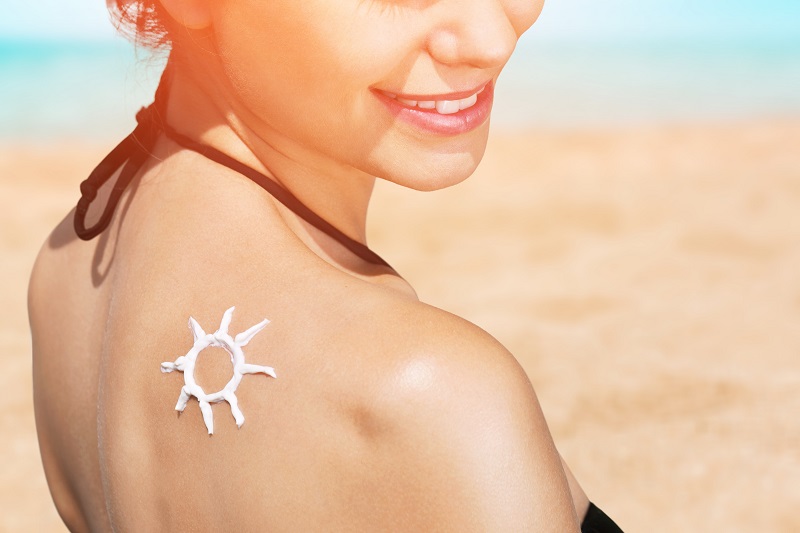Z roku na rok wzrasta nasza świadomość odnośnie zagrożeń, jakie niesie ze sobą opalanie. Wystawianie skóry na działanie promieni UV czy regularne wizyty w solarium przestały być czymś, z czego można być dumną. Nie każdej z nas jednak odpowiada blada cera. Na szczęście istnieje sposób na opaloną skórę bez narażania jej na szkody. Zanim się jednak zdecydujemy na sztuczną opaleniznę, warto sprawdzić, jak działają samoopalacze i czy ich używanie jest na pewno całkowicie bezpieczne.
Lato w pełni, co oznacza sezon urlopów i godzin spędzonych na plaży. Warto jednak pamiętać, że opalanie bez umiaru może przynieść znacznie więcej szkody niż pożytku i nie mówimy jedynie o chwilowych cierpieniach spowodowanych oparzeniami słonecznymi. Nie od dziś wiadomo, że promienie UV niszczą kolagen, elastynę i kwas hialuronowy w naszej skórze. Tym samym przyspieszają pojawienie się zmarszczek i starzenie się skóry. Niestety to nie wszystko – przyczyniają się do powstawania przebarwień, a nawet nowotworów.
Z tego powodu nawet w pochmurny dzień nie warto zapominać o kremie z wysokim filtrem. Oczywiście wiemy, jak działa opalenizna (co jasne, ta subtelna) – optyczne wyszczupla i ujędrnia nasze ciało. Z tego powodu tak wiele z nas nie wyobraża sobie, by z niej zrezygnować. Zamiast jednak katować swoją skórę na słońcu, warto postawić na znacznie bezpieczniejsze metody, czyli samoopalacze. W jaki sposób działają? Co takiego mają w swoim składzie, że zaledwie w kilka godzin potrafią wyczarować oliwkową opaleniznę? O tym poniżej!
Sposób na sztuczną opaleniznę
Do najpopularniejszych metod z pewnością należy samoopalacz, który królował na naszym rynku kilkanaście lat temu. Warto zwrócić jednak uwagę, że dzisiejsze kosmetyki mają niewiele wspólnego z pamiętnymi balsamami i sprayami, za sprawą których całe populacje polskich miast dotknęła przypadłość pomarańczowej skórki (bynajmniej nie mówimy o cellulicie! :)). Niestety wiele z nas ma już wyrobioną opinię na ich temat i unika tych specyfików jak ognia – naprawdę niepotrzebnie. Jaka jest alternatywa dla tradycyjnych samoopalaczy?
Metodą coraz bardziej zyskującą na popularności jest opalanie natryskowe, czyli tzw. Airbrush Tanning. Technika ta oczywiście przywędrowała do nas ze Stanów Zjednoczonych. Dlaczego jest tak chętnie stosowana? Przede wszystkim ze względu na wygodę. W przeciwieństwie do stosowania samoopalacza, które jest czasochłonne, a czasem i żmudne, w tym w przypadku wystarczy się oddać w ręce specjalistki, która dosłownie w kilka minut przeobrazi nas z albinoski w mulatkę. O tym, jak dokładnie działają obie metody, dowiesz się z dalszej części artykułu.
W tym miejscu warto jednak przywołać także zupełnie naturalne sposoby na opaleniznę. Już nasze babcie znały i korzystały z cudownego działania marchewki i innych produktów zawierających w swoim składzie beta-karoten. Regularne spożywanie tej substancji wspomaga wydzielanie pigmentu, co oznacza, że nasza skóra z czasem nabierze delikatnie złotego kolorytu. Równie dobrze możemy zacząć wsmarowywać w naskórek olej z nasion marchwi bądź domowy samoopalacz. Jak go przygotować?
Domowy samoopalacz z kakao
Naturalne kosmetyki są ostatnimi czasy coraz bardziej popularne. Od dawna korzystamy z domowych maseczek, peelingów, a nawet kremów. Kto zatem powiedział, że nie możemy pokusić się o stworzenie samoopalacza? W tym celu wystarczy znaleźć szczelny szklany pojemnik, w którym umieścimy kolejno wszystkie składniki:
- szklanka płynnego oleju kokosowego,
- 1 łyżeczka kakao,
- ¼ łyżeczki świeżo startej gałki muszkatołowej,
- 1 łyżeczka cynamonu.
Miksturę należy dokładnie wymieszać i wsmarowywać ją w skórę codziennie po kąpieli. Niestety na efekt będziemy musiały trochę poczekać, bo nawet kilka tygodni. Taka opalenizna nada jednak skórze delikatny złotawy odcień i wyrówna jej koloryt.
Jak działa samoopalacz?
Czas na wyjaśnienie zagadki – w jaki sposób krem wywołuje opaleniznę? Za wszystko odpowiedzialny jest oczywiście skład produktu. Zazwyczaj w samoopalaczach znajdziemy DHA, czyli dihydroxyaceton – substancję, która wchodząc w reakcję z aminokwasami zawartymi w komórkach naszego naskórka, powoduje zmianę ich koloru.
Co ważne, samoopalacz nie dociera do skóry właściwej, a zatem nie wpływa w sposób stały na jej zdrowie. Zmiany kolorytu zachodzą jedynie w komórkach, które z biegiem czasu i tak obumierają i samoczynnie się złuszczają. Z tego powodu taka opalenizna nie jest trwała. Warto także pamiętać, że ostateczna barwa opalenizny zależna jest od grubości naszego naskórka a także ilości zaaplikowanego preparatu.
Czy samoopalacze są bezpieczne? Jakie są ich wady?
DHA już w latach 70. został dopuszczony przez specjalistów do użytku i wykorzystania w kosmetykach. Mimo to naukowcy do dzisiaj nie przestali go badać. Jak odkryto, produkty zawierające w swoim składzie DHA, jeśli zbyt długo stoją na sklepowych półkach bądź są wystawione na działanie promieni słonecznych, mogą stać się niebezpieczne. Pod wpływem czynników zewnętrznych dihydroxyaceton może się zacząć rozkładać na szkodliwy, a nawet rakotwórczy formaldehyd. Czy powinnyśmy się zatem zacząć obawiać i unikać samoopalaczy jak ognia?
Jeśli używamy tych kosmetyków zgodnie z przeznaczeniem, ani nie przetrzymujemy ich zbyt długo na półce, nie mamy się czego bać. Pamiętajmy, by stosować jedynie świeżo otwarte kosmetyki i starać się zużywać je jak najszybciej. W produktach starszych czy źle przechowywanych zachodzą bowiem zmiany pH – zmiany chemiczne, w wyniku których powstaje formaldehyd, który jest substancją drażniącą, a wręcz groźną. Jego działanie objawia się jako alergia skórna, podrażnienie i wysuszenie naskórka.
Niektóre z nas unikają samoopalaczy jeszcze z innego powodu, a mianowicie specyficznego zapachu, jaki kosmetyki wytwarzają w kontakcie z naszą skórą. Warto zauważyć, że aromat ten nie ma nic wspólnego z walorami zapachowymi samego produktu, kiedy ten znajduje się jeszcze w opakowaniu. Wszystkiemu winna jest reakcja DHA z aminokwasami skóry. Podczas „opalania” powstaje dość nieprzyjemny aromat, niekiedy porównywany z tym, jaki wydziela się przy… obsmażaniu mięsa. Producenci dwoją się i troją, by go zneutralizować. Niestety, bez skutku.
Alternatywa dla DHA, czyli samoopalacz z erytrulozą
Na szczęście wcale nie jesteśmy skazane na DHA. Jeśli naprawdę przeszkadza Ci specyficzny zapach tych kosmetyków bądź obawiasz się formaldehydów, pozostają jeszcze kosmetyki na bazie erytrulozy. Powstała za jej sprawą opalenizna wygląda jeszcze bardziej naturalnie – jest jednorodna i minimalizuje praktycznie do zera ryzyko powstania nieestetycznych plam czy przebarwień. Kosmetyki wykorzystujące tę substancję mają znacznie dłuższy okres przechowywania, co więcej, nie zachodzi w nich reakcja przekształcenia w formaldehyd.
Kosmetyki te jednak mają swoje wady. W ich przypadku opalenizna pojawia się dopiero po 24 godzinach, a nawet 2 dniach od wsmarowania preparatu. Ze względu na właściwości i mniejszą popularność, takie samoopalacze kosztują niestety więcej od tych tradycyjnych. Bez względu na to, na jaki preparat się zdecydujemy, musimy być świadome, że w każdym z nich znajdziemy – a wręcz powinnyśmy znaleźć! – konserwanty. Zarówno DHA, jak i erytruloza to z chemicznego punktu widzenia cukry. A skoro są cukry, mogą się pojawić i bakterie…

A może opalanie natryskowe?
Ta coraz popularniejsza metoda jest chyba jednym z najbezpieczniejszych sposobów na uzyskanie pięknej opalenizny. Co więcej, taki zabieg nie tylko przyciemni naszą skórę, ale dodatkowo ją nawilży i odżywi. Na czym dokładnie polega opalanie natryskowe? W jaki sposób działa? Przede wszystkim warto powiedzieć, że tzw. Airbrush Tanning odbywa w gabinecie kosmetycznym, w specjalistycznej kabinie.
Bezpośrednio przed zabiegiem należy dokładnie zmyć make-up, usunąć pozostałości antyperspirantu i perfum. Kosmetyczka najpierw przeprowadza suchy peeling, który wygładza skórę. Po nim czas na właściwy zabieg, czyli samo opalanie, które trwa około 15 minut. Do tego należy doliczyć czas potrzebny na suszenie ciała.
Czym różni się preparat do opalania natryskowego od samoopalacza z tubki?
Wbrew pozorom, standardowy samoopalacz wyróżnia się innym składem od tego, z którego korzysta profesjonalna kosmetyczka. Preparat, jaki wykorzystywany jest do opalania natryskowego, jest specjalną mieszanką dwóch substancji – DHA i erytrulozy. Wzbogacony jest także o składnik DMI, który wspomaga i utrwala opaleniznę. Co więcej, znajduje się w nim także wyciąg z aloesu i witaminy A i E, dzięki czemu preparat nie tylko opala, ale także silnie nawilża naskórek.
Niestety ta metoda nie jest dla wszystkich. Istnieje kilka przeciwskazań, a mianowicie alergie skóry, skaleczenia, świeże rany, nadmierna potliwość, a nawet astma. Warto pamiętać także o dość wysokiej cenie – jeden zabieg na całe ciało kosztuje zwykle około 100 zł. By efekt był bardziej trwały, zabieg należy powtórzyć po 7 dniach. Kolor w takiej sytuacji może się utrzymać nawet do kilku tygodni.
Opalenizna? Tak, ale ta „sztuczna”!
Oczywiście nie ma metody idealnej, która będzie zupełnie pozbawiona wad. Mimo wszystko, jeśli chcemy się cieszyć złocistą skórą, dobrze postawić na opaleniznę z tubki czy aplikatora natryskowego. Naprawdę nie warto narażać się na szkodliwe działanie promieni słonecznych. Chyba że chcemy okupić opaleniznę dodatkowymi zmarszczkami, a nawet poważną chorobą skóry.
O tym, jak wybrać samoopalający preparat, a także w jaki sposób go nakładać, by cieszyć się udaną opalenizną, przeczytasz już niedługo na naszym blogu!






